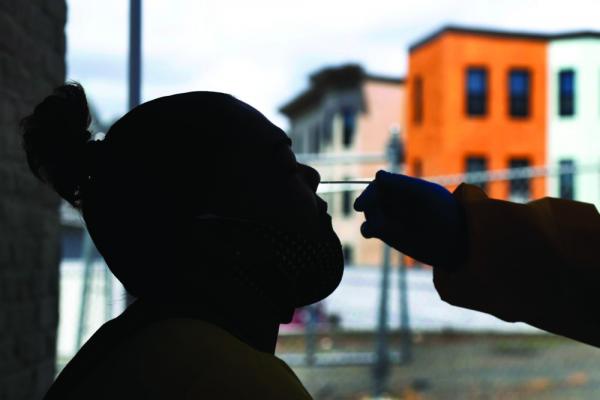August 20, 2020

A woman receives a COVID-19 test at the Whittier Street Health Center’s mobile test site, July 15, 2020, in Dorchester. Elise Amendola/AP photo
On our way to Daily Table in Codman Square on August 5, my wife and I spotted a DotHouse Health banner at Town Field. Guessing it was for COVID-19 testing, and seeing that there were not yet any customers at the tents, we stopped.
The coronavirus has made all of us fearful, angry, even desperate at times. Knowing that upwards of 40 percent of those who get the virus can be asymptomatic, and that the other 60 percent can have a variety of symptoms, we got tested.
Though we had heard that the test rammed a swab higher in your nose than you think it should, Dot House staff were professional and the discomfort was no more than five seconds. We had the test and went off to get groceries.
I received my test results electronically six days later, which said “SARS CoV2 RNA NOT DETECTED.” Though in some ways having a positive result would have been a relief, as we were both asymptomatic, the fact that it took 6 days (9 days for my wife, who got the result in the suddenly lethargic mail service) gave me no sense of comfort.
What if I had been positive? Considering that it takes symptoms 2 to 14 days to appear once the virus has made your body a host, and that you are most infectious in the first hours after the onset of infection, I would have been able to infect others before knowing that I had the virus.
This is the problem: We’re six months in and we have not deployed our resources in an effective way to get control of the virus. This failure affects our decision making on how we live our daily lives, how we educate our children, and how we get to a time when our economy can fully reopen.
We’ve learned a lot about the virus from the 5 million Americans who have tested positive and the more than 170,000 who have died from COVID. We know that it is mainly spread by aerosolized droplets from people breathing, particularly when singing or speaking loudly.
We know that physical distancing, masks, hand hygiene ,and disinfecting surfaces help prevent the spread of the virus, and that being outside is safer than being inside. We know that viral load, i.e., how much virus you have in you, determines whether you are infectious and we have treatments for those who need hospitalization, which has lowered the death rate.
We know that, while most people are asymptomatic or have mild symptoms, others wind up with catastrophic symptoms, and that a percentage of people will have the virus for a longer time, which may be months or longer. We also know that at some point, people who are infected stop being infectious, despite still having the virus in them.
Our country reopened too soon, and we’re paying for it now. In the entirety of World War I, the US had 116,516 deaths, more than half from the influenza pandemic of 1918. At our current rate, we’ll have more than 200,000 deaths by Oct. 1.
So what’s our best opportunity to curtail the virus? At the risk of stating the obvious, everyone must practice physical distancing, wear masks, practice hand hygiene, and disinfect surfaces. And stay outside as much as possible.
However, two critical matters remain unresolved: We need test results in minutes, not days, to know whether a person needs to be separated from others. And we need many more tests. Testing that takes a week to produce a result is useless for stopping the virus from spreading. Most people lose their infectiousness within ten days of getting the virus, so you’ll find out if you have the virus around the time you’re not likely to spread it.
The good news on this front is that we have point-of-care tests —tests that can easily be done in your home, an office or school (think pregnancy test)— that have results in 10-15 minutes. A group of 50 urgent care centers in the New York metropolitan area have invested in these tests and in the machinery necessary to perform them and can now provide that service.
But the most potent solution would be providing a test that is cheap enough to give several times a week to anyone who is going to be sharing space. With the understanding that viral load determines infectiousness, we don’t need to have super-sensitive and costly tests to determine if a person is infectious.
These cheaper saliva tests, which can be done at home or school, are very close to being developed. In fact, more than a dozen such tests are in process, many of them near completion.
So, what does this mean for getting our children back to school? We know that children can get infected. In fact, nearly l00,000 American children were infected in the last two weeks of July alone. We know from many studies that children can infect others, though they don’t get as sick, and transmission is lower than the adult population.
On the other hand, children spread viruses and germs following the start of school — ask any parent.
It’s clear that most school committees have come to the conclusion that it’s best to be careful and see what happens elsewhere where children are going back to the classroom. And the testing cavalry may be just over the next hill.
Bill Walczak is a Dorchester resident and co-founder and former CEO of the Codman Square Health Center.



